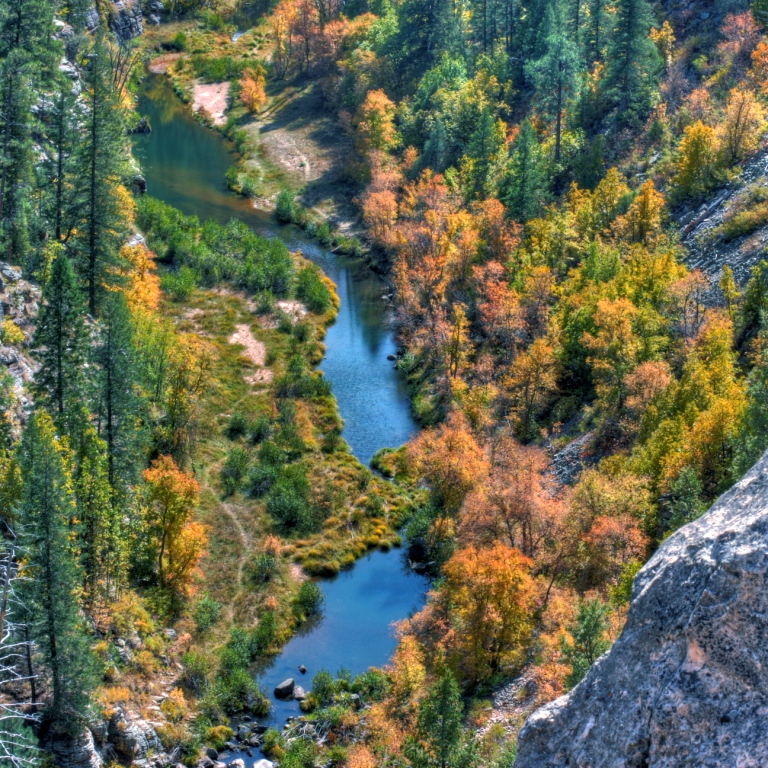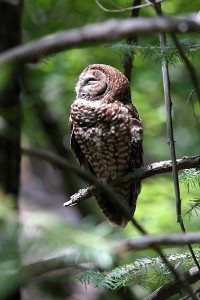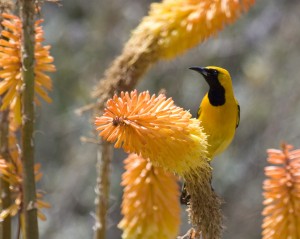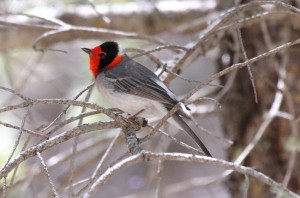Identified: 01/2004
Visiting the Site: Located adjacent to the New Mexico border, northeast of Clifton and south of Alpine. For access from the north and Alpine take county route 12 toward Reserve, N.M. and Luna Lake. Turn south on Forest Road 281 into the IBA and to a trailhead into the Blue Primitive Area. The Strayhorse Trail is a hiking access into the middle of the IBA from the west. The trailhead is at Rose Peak campground on Highway 191 Forest Road 475 at the Juan Miller campgrounds is a dirt road access about 25 miles north of Clifton. The San Francisco River portion of the IBA is very remote.
Ownership: Apache-Sitgreaves National Forest (private lands with permission).
Site Description: Elevation ranges from nearly 9,000 feet at the highest points of the Campbell Blue headwaters near Alpine to about 3,300 feet along the San Francisco near Clifton. Of the total 400,000-acre Blue River watershed, 99% is managed by the U.S. Forest Service for the public. Fifty-five percent of the watershed is a designated Primitive Area. The Blue and San Francisco River systems are free-flowing, perennial riverine systems. Cottonwoods, willows, alders, and sycamores are the dominant riverside trees. The upland habitats are pine and mixed conifer at its highest points, and gradually including habitats such as pinyon-juniper, Madrean oak and chaparral in its middle elevation ranges, and desert grassland with mesquite in its lower segment. The river corridor and its uplands also include areas that are canyon confined, with high, rocky cliffs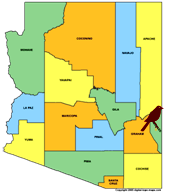
Birds: To date, 216 species have been documented in this IBA with 138 likely breeding.
Breeding: Conservation status species include: Mexican Spotted Owl, Yellow-billed Cuckoo, Cordilleran Flycatcher, Purple Martin, Bell’s Vireo, Lucy’s Warbler, Hooded Oriole, Gray Catbird, Bendire’s Thrasher, MacGillivray’s Warbler, Black-throated Gray Warbler, Juniper Titmouse, Gray Vireo, Black-chinned Sparrow, and American Dipper.
Non-conservation status breeding species include: Yellow-breasted Chat, Summer Tanager, Blue Grosbeak, Golden Eagle, Peregrine Falcon, Northern Goshawk and White-throated Swift, Belted Kingfisher, Red-faced Warbler, and Common Black-Hawk.
Migration: Great Egret, Snowy Egret, Osprey, Bald Eagle, Solitary Sandpiper, Willow Flycatcher. American Avocet, Western Grebe, Tree Swallow, Peregrine Falcon, Merlin, and Bald Eagle.
Conservation Concerns: Historically, the greatest stress to the river system has been caused by livestock grazing, which caused significant hydrological changes. The U.S. Forest Service has acted to remove most livestock grazing from the main Blue River over the last decade, allowing for the natural regeneration of the riparian habitat and recovery of natural hydrological processes. Exotic crayfish are present in the streams and pose significant threat to native fish, amphibians, and aquatic invertebrates on which native species depend.
Conservation Stewards: White Mountains Audubon Society, Arizona Wilderness Coalition.
Map of Important Bird Area:

State of the IBAs 2014 Baseline – More Technical info about the status of this Important Bird Area
San Francisco Blue | Arizona Wildlife Conservation Strategy
Complete eBird.org Checklist of birds Reported for Blue and San Francisco Rivers IBA
For an interactive map and habitat and land ownership analysis of this IBA visit the National Audubon IBA Map and select “Arizona” and then select this IBA
Location: 31.56° N: 111.3° W
County: Greenlee
Site Status: Identified (Federal lands only) 01/2004
Ownership: Apache-Sitgreaves National Forest
Area: 166.6 square miles, 106,642 acres
Criteria: Global (Potential): Species of Conservation Concern (Mexican Spotted Owl)
State: Species of Conservation Concern
State: Species in rare/unique habitat
State: Outstanding landbird stopover
Site Description: This IBA area begins at the point of entry of the Blue River into Arizona (from its headwaters in New Mexico), which is east of Alpine, AZ. The site follows the Blue River to its confluence with the San Francisco River and includes the selected tributaries of the Campbell Blue River and KP Creek. The site also includes the San Francisco River from its entrance into Arizona, and ends near Clifton, AZ. The Blue River nomination area includes approximately 40 miles of the Blue River, ten miles of the Campbell Blue River, 5 miles of KP Creek, and over 20 miles of that portion of the San Francisco River under Forest Service jurisdiction in Arizona. This river system and approximately a 3/4 mile buffer on either side comprise this site. The remoteness and limited accessibility to this area may be an asset to long-term conservation of its riparian and associated habitats that are at risk from disappearing throughout Arizona and the Southwest.
Ornithological Summary:
| Species or group | Season | Maximum | Year |
| Mexican Spotted Owl | Breeding | 17 Pairs | 1995 |
| Northern Goshawk | Breeding | Present | 2003 |
| Peregrine Falcon | Breeding | Present | 2001 |
| Riparian Habitat | Breeding | 52 Species of Greatest Conservation Need Arizona | 2025 |
There were 17 Active Nests of Mexican Spotted Owl documented in 1995 from Clifton Ranger District only, plus 10 alternate nests. To date, 216 species have been documented with 138 likely breeding. Surveys have documented breeding “special status” species which are riparian obligatory or have strong association to riparian corridors such as Common Black-Hawk, Yellow-billed Cuckoo, Belted Kingfisher, Cordilleran Flycatcher, Purple Martin, Bell’s Vireo, Lucy’s Warbler, and Hooded Oriole. Gray Catbird, Bendire’s Thrasher and MacGillivray’s Warbler are also suspected to be breeding (ABBA 1993-2001). The presence of other (non-listed) breeding riparian-obligatory species has been documented, and this list includes American Dipper, Yellow-breasted Chat, Summer Tanager, and Blue Grosbeak. In addition, the following “special status” species are also known to use the riparian corridor in migration or winter: Great Egret, Snowy Egret, Osprey, Bald Eagle, Solitary Sandpiper, and Willow Flycatcher.
Also, documented are examples of breeding “special status” habitat obligates or associates which indicate the presence of a variety of suitable nesting habitats, and the potential for additional suites of species. For example, Golden Eagle, Peregrine Falcon, and White-throated Swift representing cliff habitat; Northern Goshawk and Mexican Spotted Owl representing mature ponderosa pine stands, Greater Pewee and Red-faced Warbler representing Pine-Oak habitat; Juniper Titmouse, Gray Vireo, and Black-throated Gray Warbler for pinyon-juniper woodlands, and Black-chinned Sparrow representing chaparral.
Other Flora/Fauna: This site is also a significant native fishery resource and has been designated as Critical Habitat for the loach minnow and spikedace. There is a Mexican Wolf Recovery area located within the Blue River watershed where reintroduction efforts have been taking place.
Conservation Issues: Historically, the greatest stress to the river system has been caused by livestock grazing, which caused significant hydrological changes. Removal of upland and riparian vegetation and the exposure of highly erosive soils contributed to increased erosion, subsequent reduction in the natural meandering of the stream, scouring, sedimentation, flooding, and channelization of the river corridor. The U.S. Forest Service has acted to remove most livestock grazing from the main Blue River over the last decade, allowing for the natural regeneration of the riparian habitat and recovery of natural hydrological processes.
Bark beetle infestation and drought stress in the upper watershed along with fire suppression contribute to a risk of catastrophic fire. Such a catastrophic fire threatens vegetation and can cause adverse changes to the hydrology of the river through loss of old trees, exposure of erosive soils, potential flooding, sedimentation, and scouring.
Exotic crayfish are present in the streams and pose significant threat to native fish, amphibians, and aquatic invertebrates on which native species depend.


